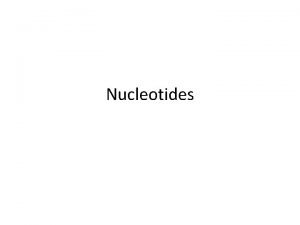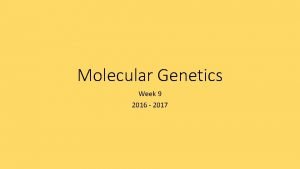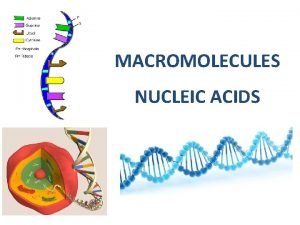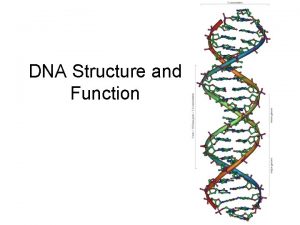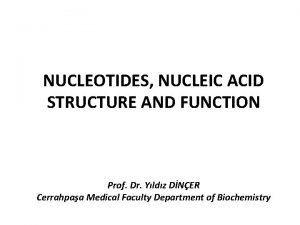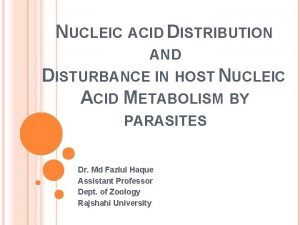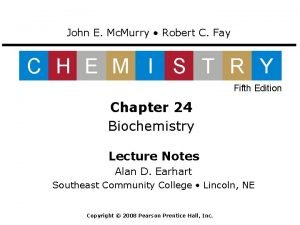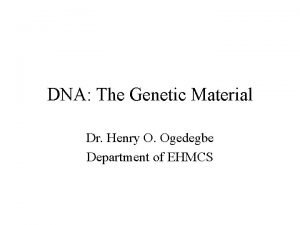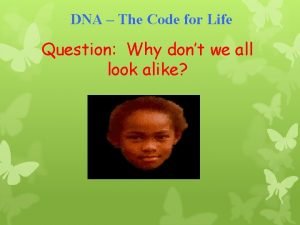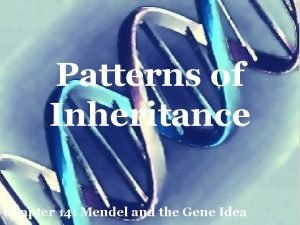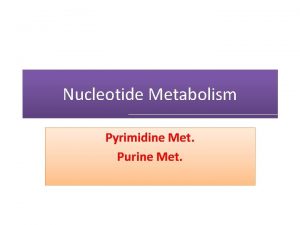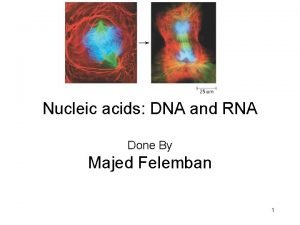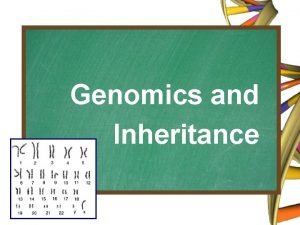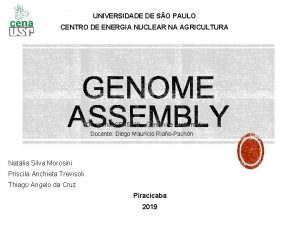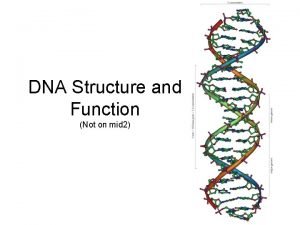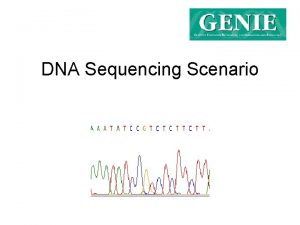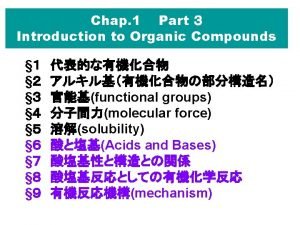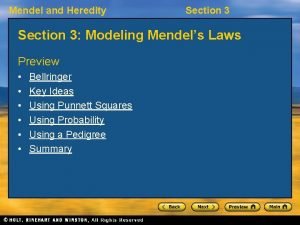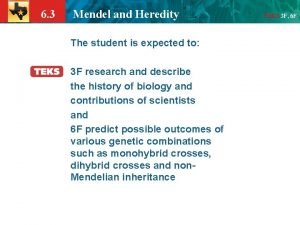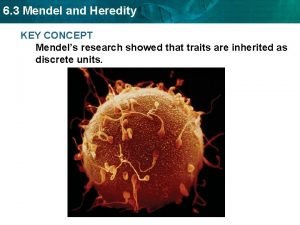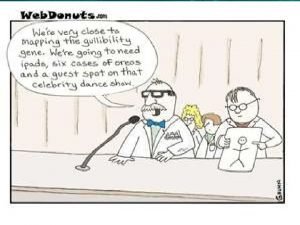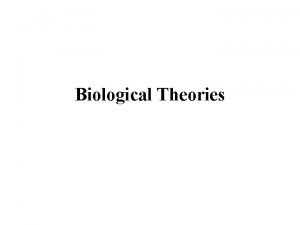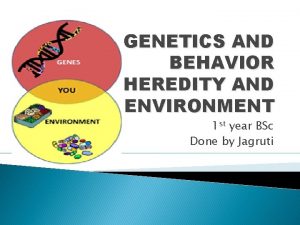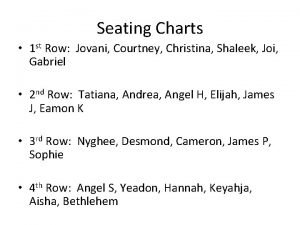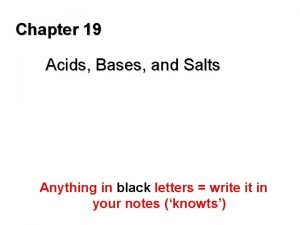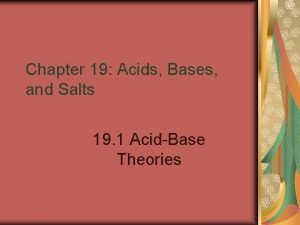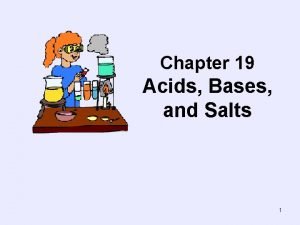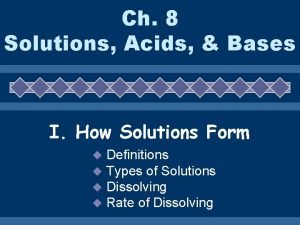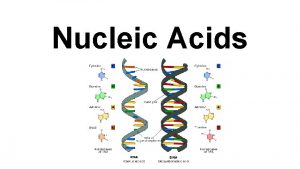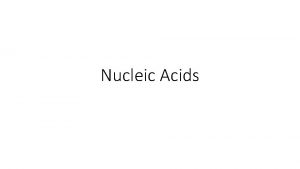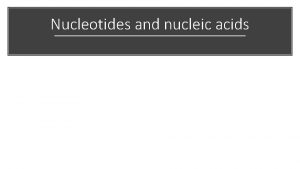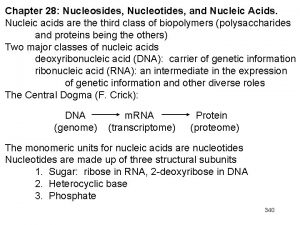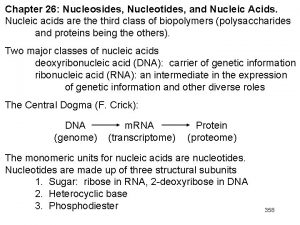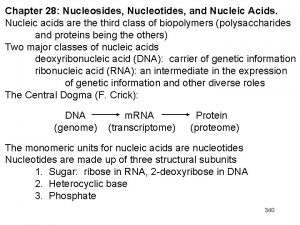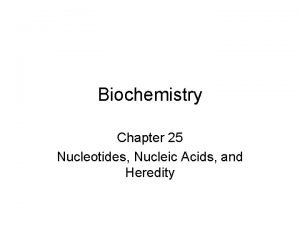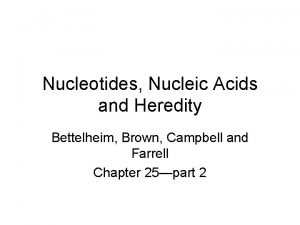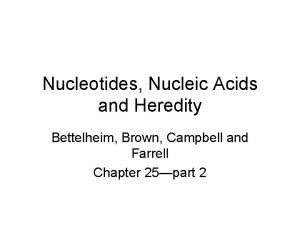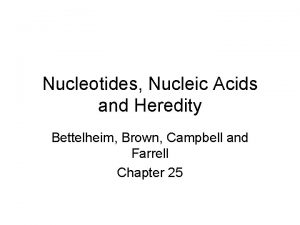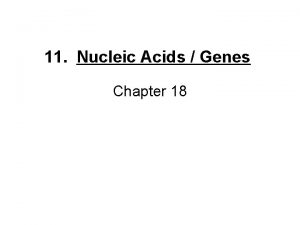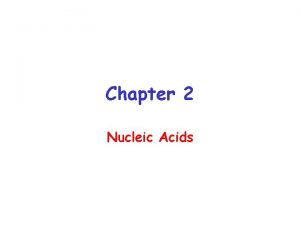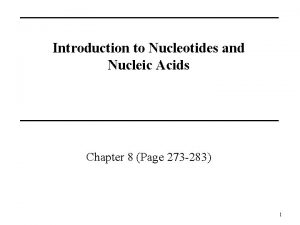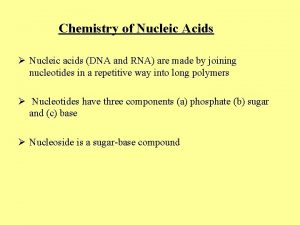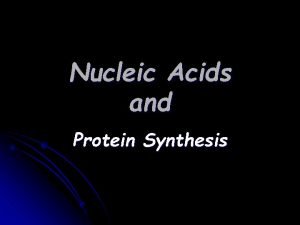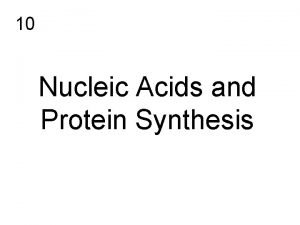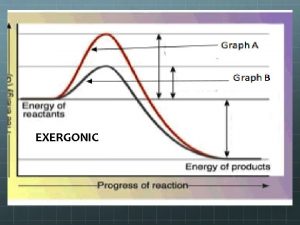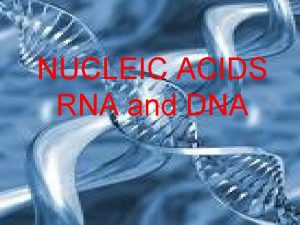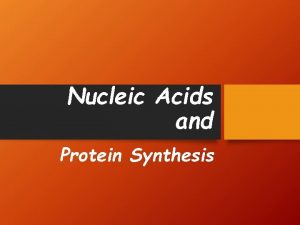Chapter 17 Nucleotides Nucleic Acids and Heredity Introduction













































- Slides: 45

Chapter 17 Nucleotides, Nucleic Acids, and Heredity

Introduction • each cell of our bodies contains thousands of different proteins • how do cells know which proteins to synthesize out of the extremely large number of possible amino acid sequences? • from the end of the 19 th century, biologists suspected that the transmission of hereditary information took place in the nucleus, more specifically in structures called chromosomes • the hereditary information was thought to reside in genes within the chromosomes • chemical analysis of nuclei showed chromosomes are made up largely of proteins called histones and nucleic acids

Introduction • by the 1940 s it became clear that deoxyribonucleic acids (DNA) carry the hereditary information • other work in the 1940 s demonstrated that each gene controls the manufacture of one protein • thus, the expression of a gene in terms of an enzyme protein led to the study of protein synthesis and its control

Nucleic Acids • There are two kinds of nucleic acids in cells • ribonucleic acids (RNA) • deoxyribonucleic acids (DNA) • Both RNA and DNA are polymers built from monomers called nucleotides • A nucleotide is composed of • a base • a monosaccharide • a phosphate

Pyrimidine/Purine Bases • The nitrogen bases in nucleotides consist of two general types: - purines: adenine (A) and guanine (G) - pyrimidines: cytosine (C), thymine (T) and Uracil (U)

Pentose Sugars • There are two related pentose sugars - RNA contains ribose - DNA contains deoxyribose • The sugars have their carbon atoms labeled with primes to distinguish them from the nitrogen bases

Nucleosides • Nucleoside: a compound that consists of D-ribose or 2 -deoxy-D-ribose bonded to a purine or pyrimidine base by a -N-glycosidic bond

Nucleotides • Nucleotide: a nucleoside in which a molecule of phosphoric acid is esterified with an -OH of the monosaccharide, most commonly either the 3’ or the 5’-OH

Nucleotides • deoxythymidine 3’-monophosphate (3’-d. TMP)

AMP, ADP and ATP • • Additional phosphate groups can be added to the nucleoside 5’monophosphates to form diphosphates and triphosphates ATP is the major energy source for cellular activity

Naming nucleosides and nucleotides • Nucleosides are named by changing the nitrogen base ending to –osine for purines and –idine for pyrimidines • Nucleotides are named using the name of the nucleoside followed by 5’-monophosphate

Names of nucleosides and nucleotides

Structure of DNA and RNA • Primary Structure can be divided into two parts: 1) sugar-phosphate backbone 2) side-chain bases • Nucleic acids are polymers of nucleotides • Their primary structure is the sequence of nucleotides • The backbone of DNA or RNA has two ends: a 5’-OH end a 3’-OH end • base sequence is read from the 5’ end to the 3’ end

Nucleic Acid - 1° Structure • A schematic diagram of a nucleic acid

Primary Structure The nucleotides in nucleic acids are joined by phosphodiester bonds • The 3’-OH group of the sugar in one nucleotide forms an ester bond to the phosphate group on the 5’-carbon of the sugar of the next nucleotide •

RNA Primary Structure • In RNA, A, C, G, and U are linked by 3’-5’ ester bonds between ribose and phosphate

DNA Primary Structure • In DNA, A, C, G, and T are linked by 3’-5’ ester bonds between deoxyribose and phosphate

Reading Primary Structure • A nucleic acid polymer has a free 5’-end a free 3’-end • The sequence is read from the free 5’-end using the letters of the bases • This example reads 5’—A—C—G—T— 3’

DNA - 2° Structure • Secondary structure: the ordered arrangement of nucleic acid strands • the double helix model of DNA 2° structure was proposed by James Watson and Francis Crick in 1953 • Double helix: a type of 2° structure of DNA molecules in which two antiparallel polynucleotide strands are coiled about the same axis • Base pairing: the two strands are held together by hydrogen bonding between base pairs

The DNA Double Helix

Base Pairing

Higher Structure of DNA • DNA is coiled around proteins called histones • histones are rich in the basic amine acids Lys and Arg, whose side chains have a positive charge • the negatively-charged DNA molecules and positivelycharged histones attract each other and form units called nucleosomes • nucleosome: a core of eight histone molecules around which the DNA helix is wrapped • nucleosomes are further condensed into chromatin • chromatin fibers are organized into loops, and the loops into the bands that provide the superstructure of chromosomes

Chromosomes

Chromosomes

Chromosomes

Chromosomes

DNA and RNA • The three differences in structure between DNA and RNA are • DNA bases are A, G, C, and T; the RNA bases are A, G, C, and U • the sugar in DNA is 2 -deoxy-D-ribose; 2 -deoxy-D-ribose in RNA it is Dribose • DNA is always double stranded; stranded there are several kinds of RNA, all of which are single-stranded

RNA • RNA molecules are classified according to their structure and function

Structure of t. RNA

Genes, Exons, and Introns • Gene: a segment of DNA that carries a base sequence that directs the synthesis of a particular protein, t. RNA, or m. RNA • there are many genes in one DNA molecule • in bacteria the gene is continuous • in higher organisms the gene is discontinuous • Exon: a section of DNA that, when transcribed, codes for a protein or RNA • Intron: a section of DNA that does not code for anything functional

Genes, Exons, and Introns • introns are cut of m. RNA before the protein is synthesized

DNA Replication • Replication involves separation of the two original strands and synthesis of two new daughter strands using the original strands as templates • DNA double helix unwinds at a specific point called an origin of replication • polynucleotide chains are synthesized in both directions from the origin of replication; that is, DNA replication is bidirectional • at each origin of replication, there are two replication forks, forks points at which new polynucleotide strands are formed

DNA Replication • DNA is synthesized from its 5’ -> 3’ end (from the 3’ -> 5’ direction of the template) • the leading strand is synthesized continuously in the 5’ -> 3’ direction toward the replication fork • the lagging strand is synthesized semidiscontinuously as a series of Okazaki fragments, fragments also in the 5’ -> 3’ direction, but away from the replication fork • Okazaki fragments of the lagging strand are joined by the enzyme DNA ligase • replication is semiconservative: each daughter strand contains one template strand one newly synthesized strand

DNA Replication

Replisomes • Replisomes are assemblies of “enzyme factories”

DNA Replication • Opening up the superstructure • during replication, the very condensed superstructure of chromosomes is opened by a signal transduction mechanism • one step of this mechanism involves acetylation and deacetylation of key lysine residues • acetylation removes a positive charge and thus weakens the DNA-histone interactions

DNA Replication • Relaxation of higher structures of DNA • topoisomerases (also called gyrases) facilitate the relaxation of supercoiled DNA by introducing either single strand or double strand breaks in the DNA • once the supercoiling is relaxed by this break, the broken ends are joined and the topoisomerase diffuses from the location of the replication fork

DNA Replication • Unwinding the DNA double helix • replication of DNA starts with unwinding of the double helix • unwinding can occur at either end or in the middle • unwinding proteins called helicases attach themselves to one DNA strand cause separation of the double helix • the helicases catalyze the hydrolysis of ATP as the DNA strand moves through; the energy of hydrolysis promotes the movement

DNA Replication • Primer/primases • primers are short oligonucleotides of four to 15 nucleotides long • they are required to start the synthesis of both daughter strands • primases are enzymes that catalyze the synthesis of primers • primases are placed at about every 50 nucleotides in the lagging strand synthesis

DNA Replication • DNA polymerases are key enzymes in replication • once the two strands have separated at the replication fork, the nucleotides must be lined up in proper order for DNA synthesis • in the absence of DNA polymerase, alignment is slow • DNA polymerase provides the speed and specificity of alignment • along the lagging (3’ -> 5’) strand, the polymerases can synthesize only short fragments, because these enzymes only work from 5’ -> 3’ • these short fragments are called Okazaki fragments • joining of the Okazaki fragments and any remaining nicks is catalyzed by DNA ligase

DNA Repair • The viability of cells depends on DNA repair enzymes that can detect, recognize, and repair mutations in DNA • Base excision repair (BER): (BER) one of the most common repair mechanisms • a specific DNA glycosylase recognizes the damaged base • it catalyzes the hydrolysis of the -N-glycosidic bond between the incorrect base and its deoxyribose • it then flips the damaged base, completing the excision • the sugar-phosphate backbone remains intact

DNA Repair • BER (cont’d) • at the AP (apurinic or apyrimidinic) site thus created, an ap ap endonuclease endonucleas catalyzes the hydrolysis of the backbone • an exonuclease liberates the sugar-phosphate unit of the damaged site • DNA polymerase inserts the correct nucleotide • DNA ligase seals the backbone to complete the repair • NER (nucleotide excision repair) removes and repairs up to 24 -32 units by a similar mechanism involving a number of repair enzymes

Cloning • Clone: a genetically identical population • Cloning: a process whereby DNA is amplified by inserting it into a host and having the host replicate it along with the host’s own DNA • Polymerase chain reaction (PCR): an automated technique for amplifying DNA using a heat-stable DNA polymerase from a thermophilic bacterium

Cloning

Nucleic Acids End Chapter 17
 Alloburinol
Alloburinol Composition of nucleic acids
Composition of nucleic acids What is an anticodon
What is an anticodon Nucleic acid building block
Nucleic acid building block Nucleic acid monomer
Nucleic acid monomer Nucleic acid function
Nucleic acid function Ribonucleotide vs deoxyribonucleotide
Ribonucleotide vs deoxyribonucleotide Pentose sugar in rna
Pentose sugar in rna Nucleotides
Nucleotides Nucleic acids
Nucleic acids Function of nucleic acids
Function of nucleic acids Food that rich in nucleic acid
Food that rich in nucleic acid Nucleic acids
Nucleic acids Functions of nucleic acid
Functions of nucleic acid Chapter 11 complex inheritance and human heredity test
Chapter 11 complex inheritance and human heredity test Chapter 17 lesson 2 heredity and genetics
Chapter 17 lesson 2 heredity and genetics When dna untwists, unzips, and nucleotides fill in.
When dna untwists, unzips, and nucleotides fill in. Chapter 11 human heredity section 11-3
Chapter 11 human heredity section 11-3 Chapter 14 human heredity
Chapter 14 human heredity Dice and coin
Dice and coin Purine
Purine Nucleotide to amino acid
Nucleotide to amino acid Four nucleotides of dna
Four nucleotides of dna Order of nucleotides in dna
Order of nucleotides in dna Nucleotides wiki
Nucleotides wiki Functions of nucleotides
Functions of nucleotides Ddntp et dntp
Ddntp et dntp Where are new nucleotides added
Where are new nucleotides added Introduction to acids and bases webquest
Introduction to acids and bases webquest Acid definition
Acid definition Section 3 mendel and heredity
Section 3 mendel and heredity Intermediate inheritance
Intermediate inheritance Locus
Locus Role of heredity
Role of heredity Section 3 mendel and heredity
Section 3 mendel and heredity Section 3 mendel and heredity
Section 3 mendel and heredity Section 3 mendel and heredity
Section 3 mendel and heredity Section 3 mendel and heredity
Section 3 mendel and heredity Heredity and crime
Heredity and crime Zycot
Zycot Flocabulary genes and heredity answer key
Flocabulary genes and heredity answer key Chapter 14 review acids and bases section 1
Chapter 14 review acids and bases section 1 Chapter 19 acids bases and salts worksheet answer key
Chapter 19 acids bases and salts worksheet answer key Chapter 19 acids bases and salts
Chapter 19 acids bases and salts Chapter 19 acids bases and salts
Chapter 19 acids bases and salts Chapter 8 solutions acids and bases
Chapter 8 solutions acids and bases
